Attached files
| file | filename |
|---|---|
| 8-K - FORM 8-K - Celanese Corp | d72459e8vk.htm |
| EX-99.3 - EX-99.3 - Celanese Corp | d72459exv99w3.htm |
| EX-99.1 - EX-99.1 - Celanese Corp | d72459exv99w1.htm |
| EX-10.1 - EX-10.1 - Celanese Corp | d72459exv10w1.htm |
| EX-99.4 - EX-99.4 - Celanese Corp | d72459exv99w4.htm |
Exhibit 99.2
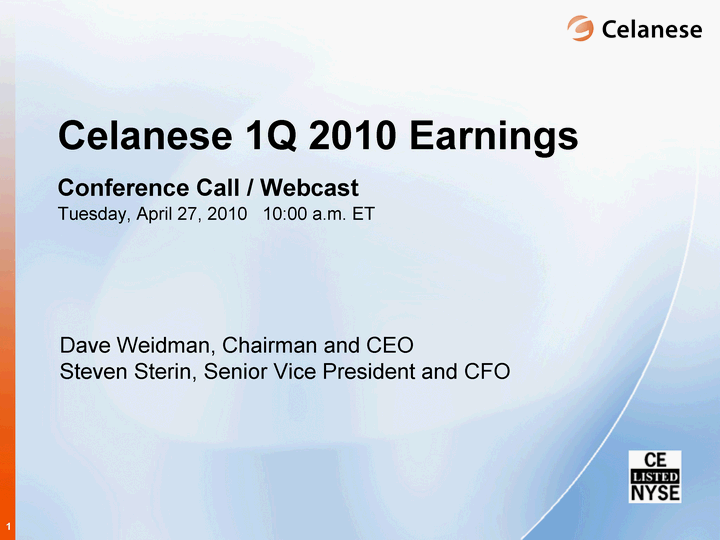
| Dave Weidman, Chairman and CEO Steven Sterin, Senior Vice President and CFO Celanese 1Q 2010 Earnings Conference Call / Webcast Tuesday, April 27, 2010 10:00 a.m. ET |
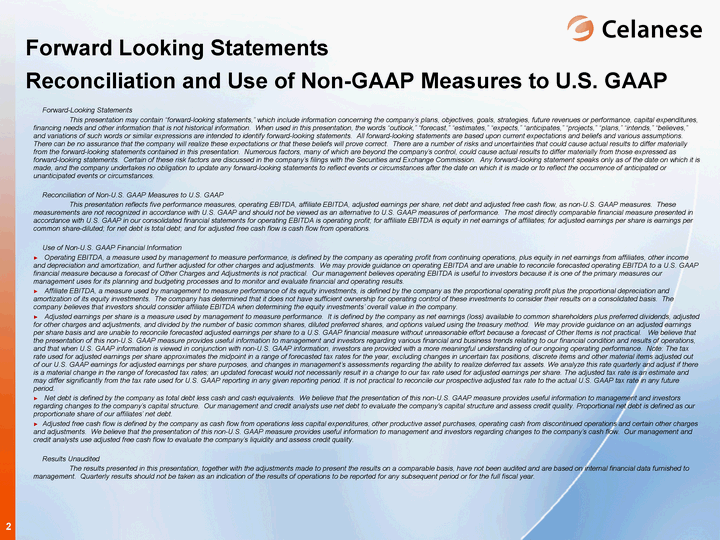
| Forward Looking Statements Reconciliation and Use of Non-GAAP Measures to U.S. GAAP Forward-Looking Statements This presentation may contain "forward-looking statements," which include information concerning the company's plans, objectives, goals, strategies, future revenues or performance, capital expenditures, financing needs and other information that is not historical information. When used in this presentation, the words "outlook," "forecast," "estimates," "expects," "anticipates," "projects," "plans," "intends," "believes," and variations of such words or similar expressions are intended to identify forward-looking statements. All forward-looking statements are based upon current expectations and beliefs and various assumptions. There can be no assurance that the company will realize these expectations or that these beliefs will prove correct. There are a number of risks and uncertainties that could cause actual results to differ materially from the forward-looking statements contained in this presentation. Numerous factors, many of which are beyond the company's control, could cause actual results to differ materially from those expressed as forward-looking statements. Certain of these risk factors are discussed in the company's filings with the Securities and Exchange Commission. Any forward-looking statement speaks only as of the date on which it is made, and the company undertakes no obligation to update any forward-looking statements to reflect events or circumstances after the date on which it is made or to reflect the occurrence of anticipated or unanticipated events or circumstances. Reconciliation of Non-U.S. GAAP Measures to U.S. GAAP This presentation reflects five performance measures, operating EBITDA, affiliate EBITDA, adjusted earnings per share, net debt and adjusted free cash flow, as non-U.S. GAAP measures. These measurements are not recognized in accordance with U.S. GAAP and should not be viewed as an alternative to U.S. GAAP measures of performance. The most directly comparable financial measure presented in accordance with U.S. GAAP in our consolidated financial statements for operating EBITDA is operating profit; for affiliate EBITDA is equity in net earnings of affiliates; for adjusted earnings per share is earnings per common share-diluted; for net debt is total debt; and for adjusted free cash flow is cash flow from operations. Use of Non-U.S. GAAP Financial Information Operating EBITDA, a measure used by management to measure performance, is defined by the company as operating profit from continuing operations, plus equity in net earnings from affiliates, other income and depreciation and amortization, and further adjusted for other charges and adjustments. We may provide guidance on operating EBITDA and are unable to reconcile forecasted operating EBITDA to a U.S. GAAP financial measure because a forecast of Other Charges and Adjustments is not practical. Our management believes operating EBITDA is useful to investors because it is one of the primary measures our management uses for its planning and budgeting processes and to monitor and evaluate financial and operating results. Affiliate EBITDA, a measure used by management to measure performance of its equity investments, is defined by the company as the proportional operating profit plus the proportional depreciation and amortization of its equity investments. The company has determined that it does not have sufficient ownership for operating control of these investments to consider their results on a consolidated basis. The company believes that investors should consider affiliate EBITDA when determining the equity investments' overall value in the company. Adjusted earnings per share is a measure used by management to measure performance. It is defined by the company as net earnings (loss) available to common shareholders plus preferred dividends, adjusted for other charges and adjustments, and divided by the number of basic common shares, diluted preferred shares, and options valued using the treasury method. We may provide guidance on an adjusted earnings per share basis and are unable to reconcile forecasted adjusted earnings per share to a U.S. GAAP financial measure without unreasonable effort because a forecast of Other Items is not practical. We believe that the presentation of this non-U.S. GAAP measure provides useful information to management and investors regarding various financial and business trends relating to our financial condition and results of operations, and that when U.S. GAAP information is viewed in conjunction with non-U.S. GAAP information, investors are provided with a more meaningful understanding of our ongoing operating performance. Note: The tax rate used for adjusted earnings per share approximates the midpoint in a range of forecasted tax rates for the year, excluding changes in uncertain tax positions, discrete items and other material items adjusted out of our U.S. GAAP earnings for adjusted earnings per share purposes, and changes in management's assessments regarding the ability to realize deferred tax assets. We analyze this rate quarterly and adjust if there is a material change in the range of forecasted tax rates; an updated forecast would not necessarily result in a change to our tax rate used for adjusted earnings per share. The adjusted tax rate is an estimate and may differ significantly from the tax rate used for U.S. GAAP reporting in any given reporting period. It is not practical to reconcile our prospective adjusted tax rate to the actual U.S. GAAP tax rate in any future period. Net debt is defined by the company as total debt less cash and cash equivalents. We believe that the presentation of this non-U.S. GAAP measure provides useful information to management and investors regarding changes to the company's capital structure. Our management and credit analysts use net debt to evaluate the company's capital structure and assess credit quality. Proportional net debt is defined as our proportionate share of our affiliates' net debt. Adjusted free cash flow is defined by the company as cash flow from operations less capital expenditures, other productive asset purchases, operating cash from discontinued operations and certain other charges and adjustments. We believe that the presentation of this non-U.S. GAAP measure provides useful information to management and investors regarding changes to the company's cash flow. Our management and credit analysts use adjusted free cash flow to evaluate the company's liquidity and assess credit quality. Results Unaudited The results presented in this presentation, together with the adjustments made to present the results on a comparable basis, have not been audited and are based on internal financial data furnished to management. Quarterly results should not be taken as an indication of the results of operations to be reported for any subsequent period or for the full fiscal year. |
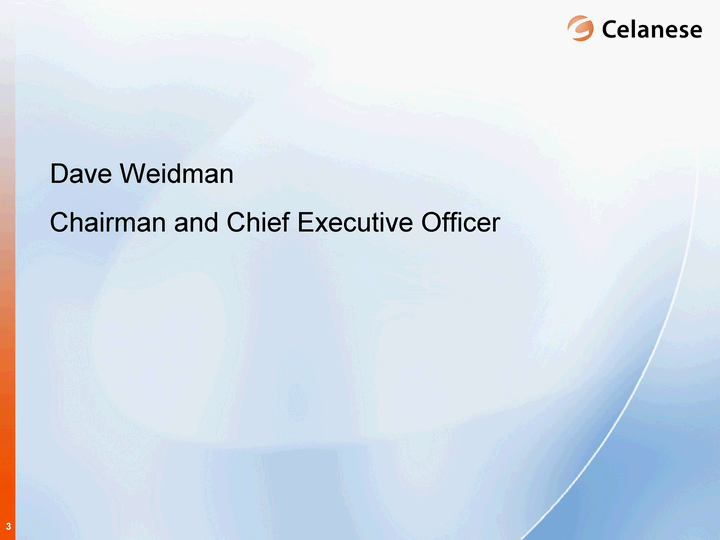
| Dave Weidman Chairman and Chief Executive Officer |
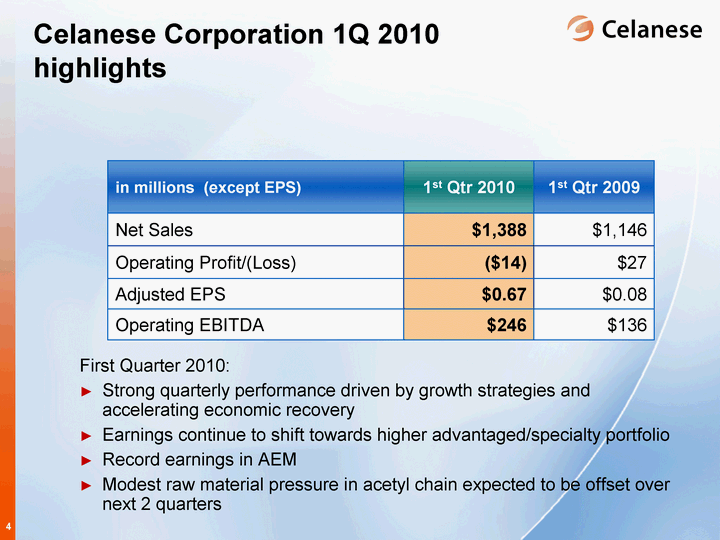
| Celanese Corporation 1Q 2010 highlights in millions (except EPS) 1st Qtr 2010 1st Qtr 2009 Net Sales $1,388 $1,146 Operating Profit/(Loss) ($14) $27 Adjusted EPS $0.67 $0.08 Operating EBITDA $246 $136 First Quarter 2010: Strong quarterly performance driven by growth strategies accelerating economic recovery Earnings continue shift towards higher advantaged/specialty portfolio Record earnings in AEM Modest raw material pressure in acetyl chain expected to be offset over next 2 quarters |
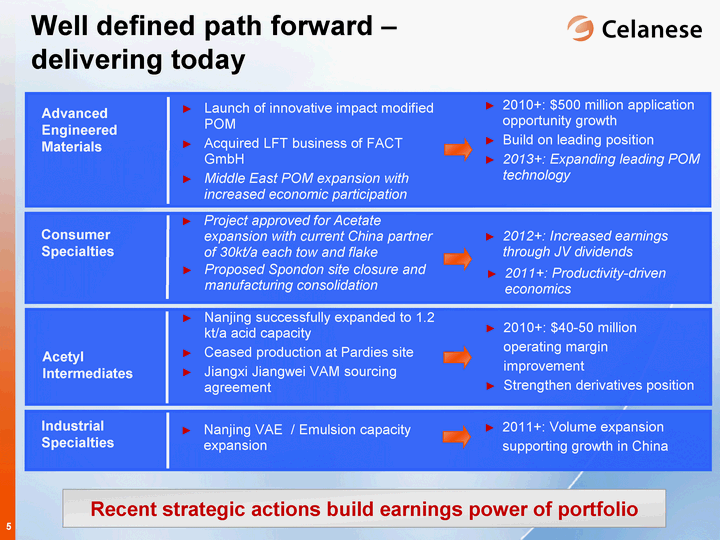
| Recent strategic actions build earnings power of portfolio Project approved for Acetate expansion with current China partner of 30kt/a each tow and flake Consumer Specialties 2012+: Increased earnings through JV dividends Nanjing VAE / Emulsion capacity expansion Industrial Specialties 2011+: Volume expansion supporting growth in China Well defined path forward - delivering today Nanjing successfully expanded to 1.2 kt/a acid capacity Ceased production at Pardies site Jiangxi Jiangwei VAM sourcing agreement Acetyl Intermediates 2010+: $40-50 million operating margin improvement Strengthen derivatives position Launch of innovative impact modified POM Acquired LFT business of FACT GmbH Middle East POM expansion with increased economic participation Advanced Engineered Materials 2010+: $500 million application opportunity growth Build on leading position 2013+: Expanding leading POM technology |
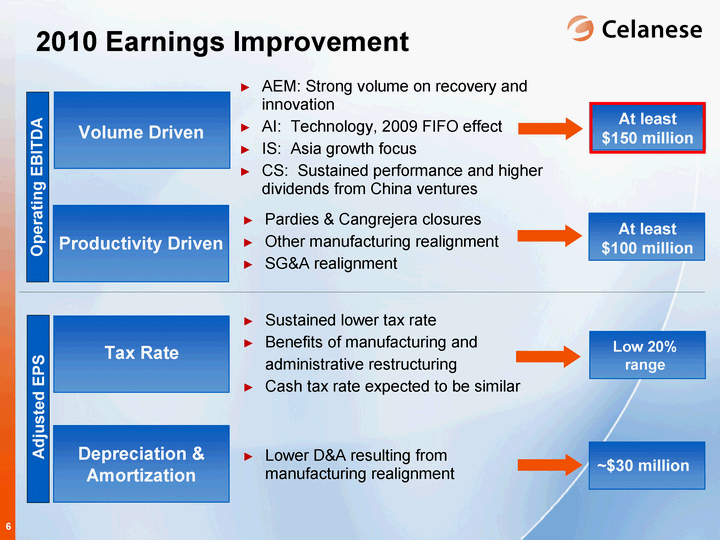
| Productivity Driven Tax Rate 2010 Earnings Improvement AEM: Strong volume on recovery and innovation AI: Technology, 2009 FIFO effect IS: Asia growth focus CS: Sustained performance and higher dividends from China ventures Pardies & Cangrejera closures Other manufacturing realignment SG&A realignment Sustained lower tax rate Benefits of manufacturing and administrative restructuring Cash tax rate expected to be similar Volume Driven At least $100 million Low 20% range Depreciation & Amortization Lower D&A resulting from manufacturing realignment ~$30 million At least $150 million Adjusted EPS Operating EBITDA |
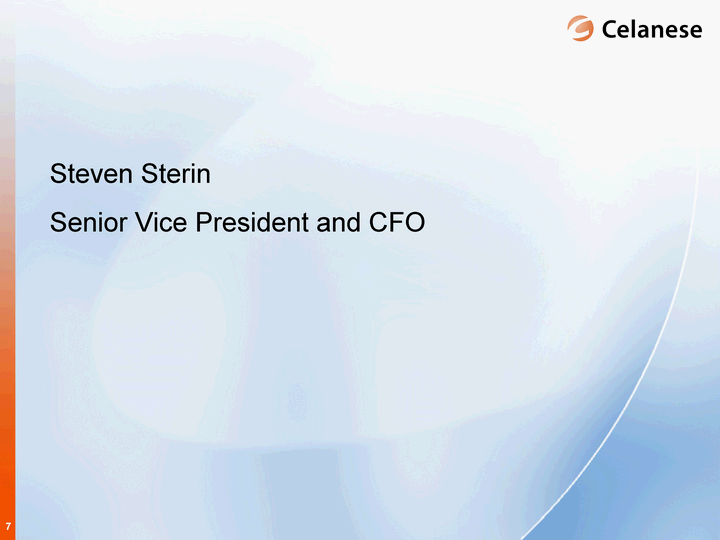
| Steven Sterin Senior Vice President and CFO |
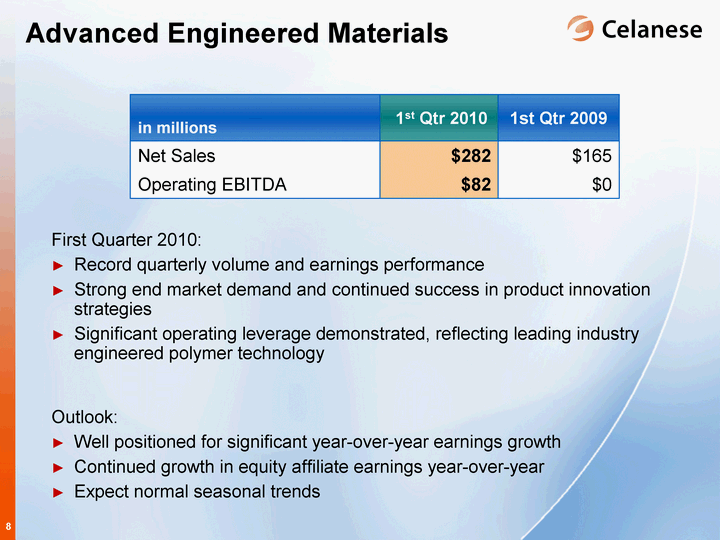
| First Quarter 2010: Record quarterly volume and earnings performance Strong end market demand and continued success in product innovation strategies Significant operating leverage demonstrated, reflecting leading industry engineered polymer technology Advanced Engineered Materials Outlook: Well positioned for significant year-over-year earnings growth Continued growth in equity affiliate earnings year-over-year Expect normal seasonal trends in millions 1st Qtr 2010 1st Qtr 2009 Net Sales $282 $165 Operating EBITDA $82 $0 |
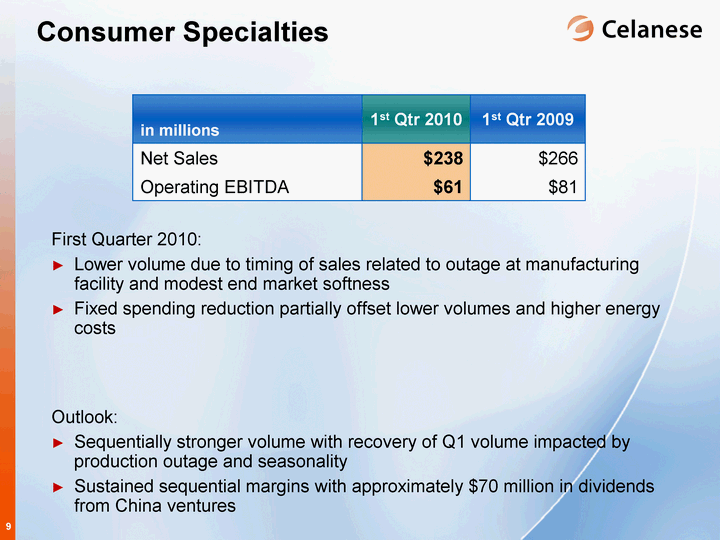
| First Quarter 2010: Lower volume due to timing of sales related to outage at manufacturing facility and modest end market softness Fixed spending reduction partially offset lower volumes and higher energy costs Consumer Specialties Outlook: Sequentially stronger volume with recovery of Q1 volume impacted by production outage and seasonality Sustained sequential margins with approximately $70 million in dividends from China ventures in millions 1st Qtr 2010 1st Qtr 2009 Net Sales $238 $266 Operating EBITDA $61 $81 |
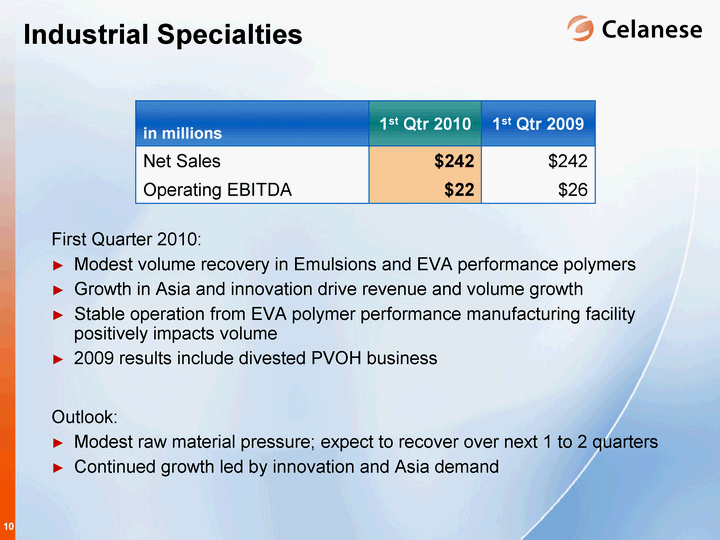
| First Quarter 2010: Modest volume recovery in Emulsions and EVA performance polymers Growth in Asia and innovation drive revenue and volume growth Stable operation from EVA polymer performance manufacturing facility positively impacts volume 2009 results include divested PVOH business Industrial Specialties Outlook: Modest raw material pressure; expect to recover over next 1 to 2 quarters Continued growth led by innovation and Asia demand in millions 1st Qtr 2010 1st Qtr 2009 Net Sales $242 $242 Operating EBITDA $22 $26 |
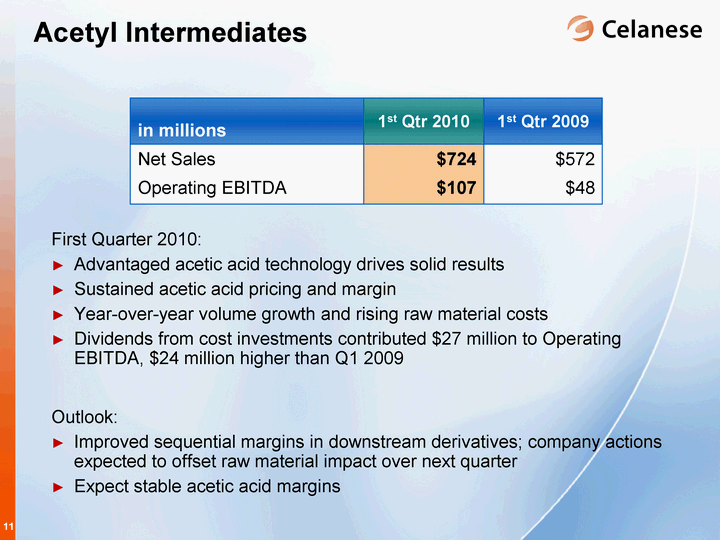
| Acetyl Intermediates First Quarter 2010: Advantaged acetic acid technology drives solid results Sustained acetic acid pricing and margin Year-over-year volume growth with rising raw material costs Dividends from the cost investments contributed $27 million to Operating EBITDA, $24 million higher than Q1 2009 Outlook: Improved sequential margins in downstream derivatives; company actions expected to offset raw material impact over next 1 to 2 quarters Expect stable acetic acid price and margins in millions 1st Qtr 2010 1st Qtr 2009 Net Sales $724 $572 Operating EBITDA $107 $48 |
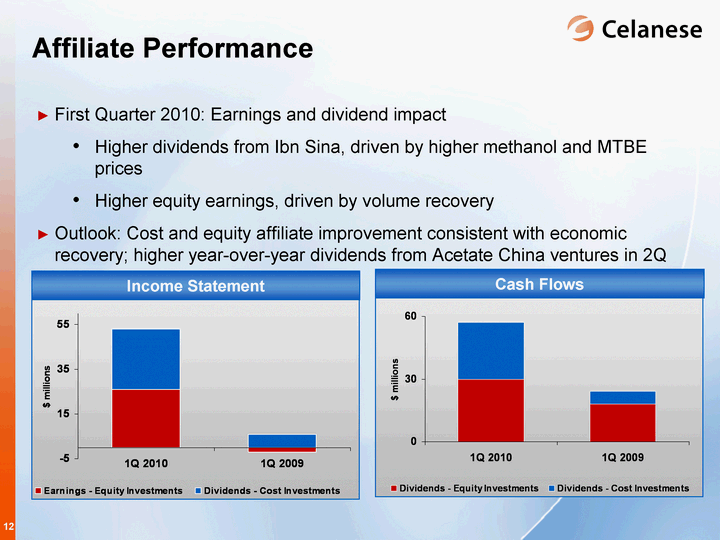
| 1Q 2010 1Q 2009 Dividends - Equity Investments 30 18 Dividends - Cost Investments 27 6 1Q 2010 1Q 2009 Earnings - Equity Investments 26 -2 Dividends - Cost Investments 27 6 First Quarter 2010: Earnings and dividend impact Higher dividends from Ibn Sina, driven by improved profitability Higher equity earnings, driven by volume recovery Outlook: Cost and equity affiliate improvement consistent with economic recovery; higher year-over-year dividends from Acetate China ventures in 2Q Income Statement Affiliate Performance Cash Flows |
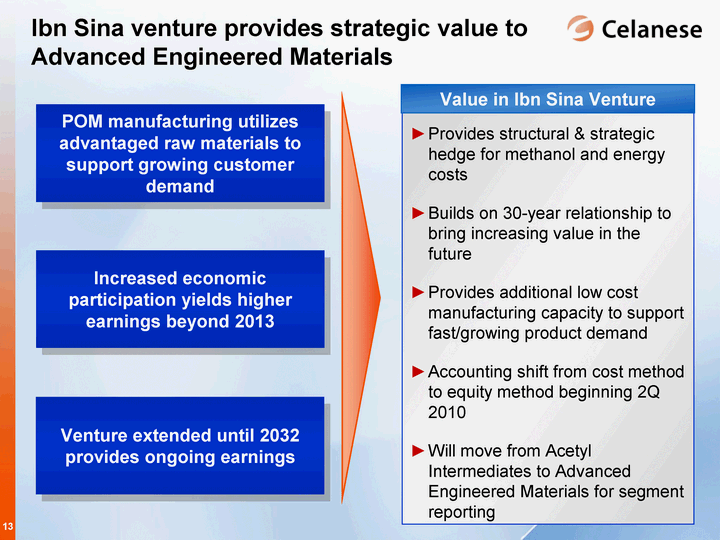
| Ibn Sina venture provides strategic value to Advanced Engineered Materials Venture extended until 2032 provides ongoing earnings POM manufacturing utilizes advantaged raw materials to support growing customer demand Increased economic participation yields higher earnings beyond 2013 Provides structural & strategic hedge for methanol and energy costs Builds on 30-year relationship to bring increasing value in the future Provides additional low cost manufacturing capacity to support fast/growing product demand Accounting shift from cost method to equity method beginning 2Q 2010 Will move from Acetyl Intermediates to Advanced Engineered Materials for segment reporting Value in Ibn Sina Venture |
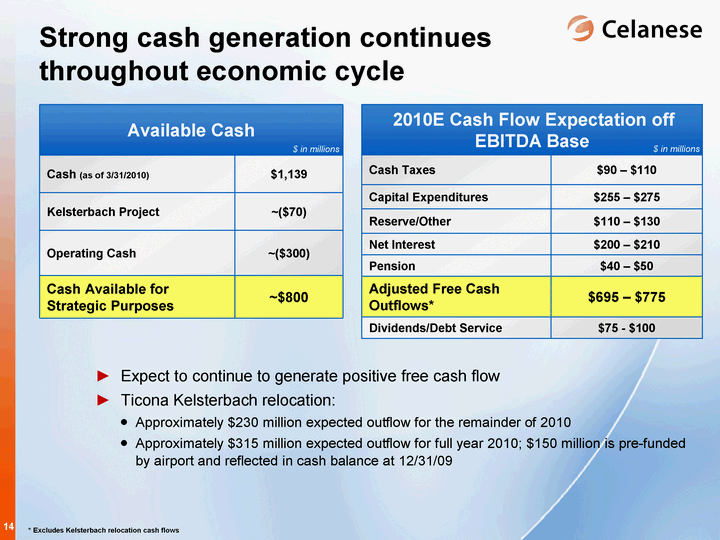
| Strong cash generation continues throughout economic cycle Available Cash Available Cash Cash (as of 3/31/2010) $1,139 Kelsterbach Project ~($70) Operating Cash ~($300) Cash Available for Strategic Purposes ~$800 Expect to continue to generate positive free cash flow Ticona Kelsterbach relocation: Approximately $230 million expected outflow for the remainder of 2010 2010E Cash Flow Expectation off EBITDA Base 2010E Cash Flow Expectation off EBITDA Base Cash Taxes $90 - $110 Capital Expenditures $255 - $275 Reserve/Other $110 - $130 Net Interest $200 - $210 Pension $40 - $50 Adjusted Free Cash Outflows $695 - $775 Dividends/Debt Service $75 - $100 $ in millions $ in millions |
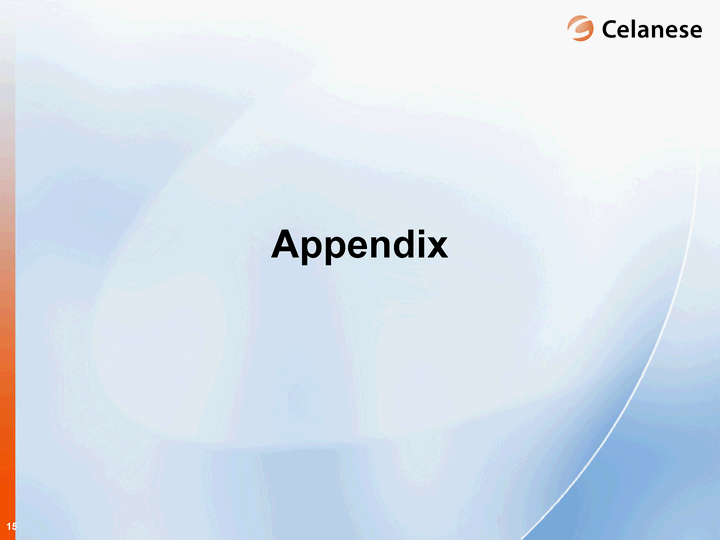
| Appendix |
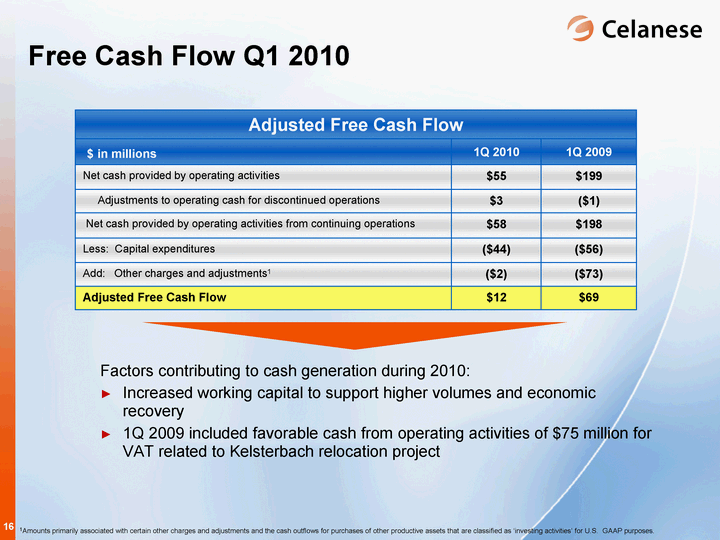
| Free Cash Flow Q1 2010 Adjusted Free Cash Flow Adjusted Free Cash Flow Adjusted Free Cash Flow $ in millions 1Q 2010 1Q 2009 Net cash provided by operating activities $55 $199 Adjustments to operating cash for discontinued operations $3 ($1) Net cash provided by operating activities from continuing operations $58 $198 Less: Capital expenditures ($44) ($56) Add: Other charges and adjustments1 ($2) ($73) Adjusted Free Cash Flow $12 $69 1Amounts primarily associated with certain other charges and adjustments and the cash outflows for purchases of other productive assets that are classified as 'investing activities' for U.S. GAAP purposes. Factors contributing to cash generation during 2010: Increased working capital to support higher volumes and economic recovery 1Q 2009 included favorable cash inflow of $75 million for VAT related to Kelsterbach relocation project |
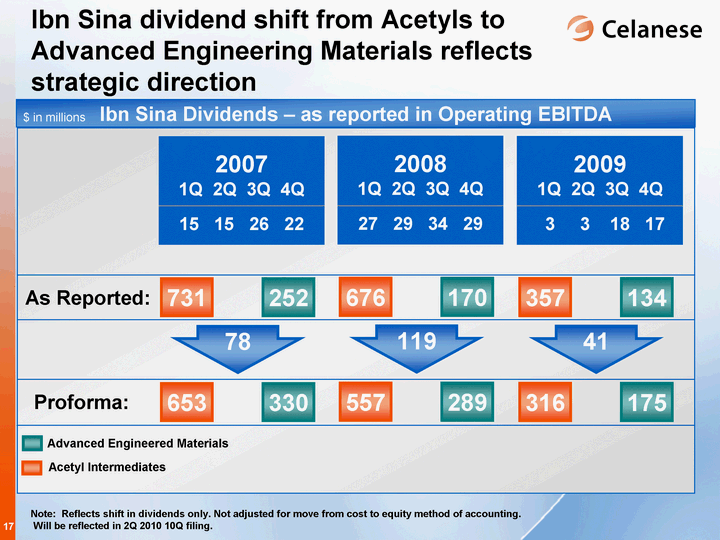
| Ibn Sina dividend shift from Acetyls to Advanced Engineering Materials reflects strategic direction Note: Reflects shift in dividends only. Not adjusted for move from cost to equity method of accounting. Will be reflected in 2Q 2010 10Q filing. 2007 1Q 2Q 3Q 4Q 15 15 26 22 252 731 330 653 As Reported: Proforma: 78 Ibn Sina Dividends - as reported in Operating EBITDA 2008 1Q 2Q 3Q 4Q 27 29 34 29 170 676 289 557 119 2009 1Q 2Q 3Q 4Q 3 3 18 17 134 357 175 316 41 Advanced Engineered Materials Acetyl Intermediates $ in millions |
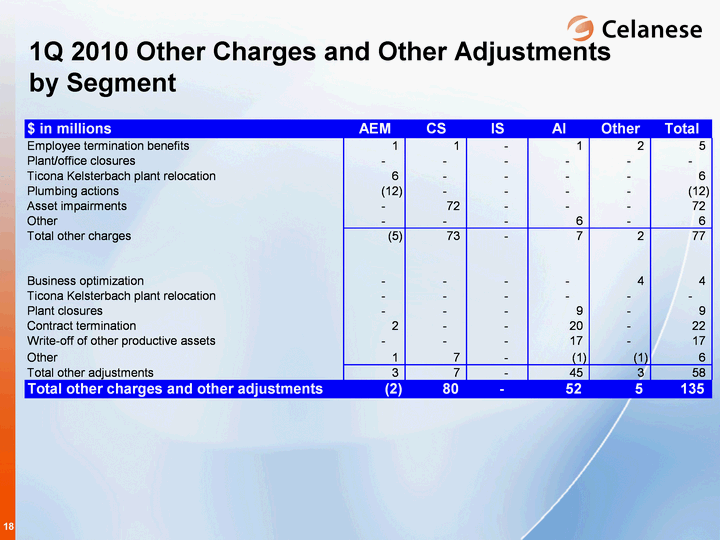
| 1Q 2010 Other Charges and Other Adjustments by Segment |
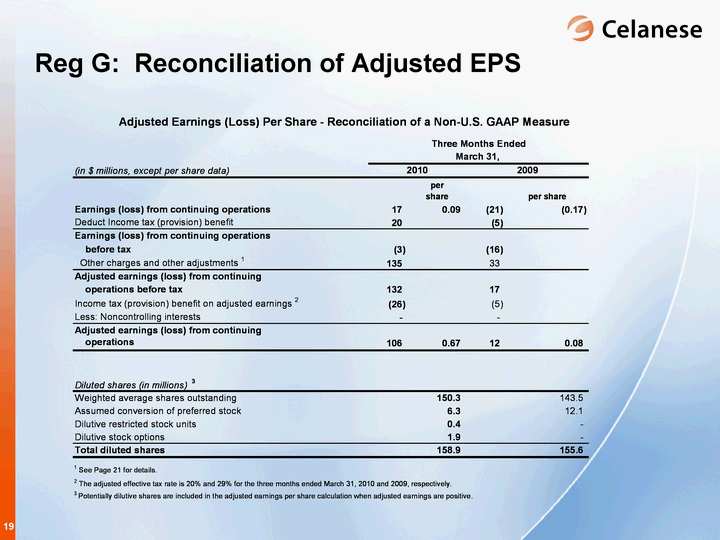
| Reg G: Reconciliation of Adjusted EPS |
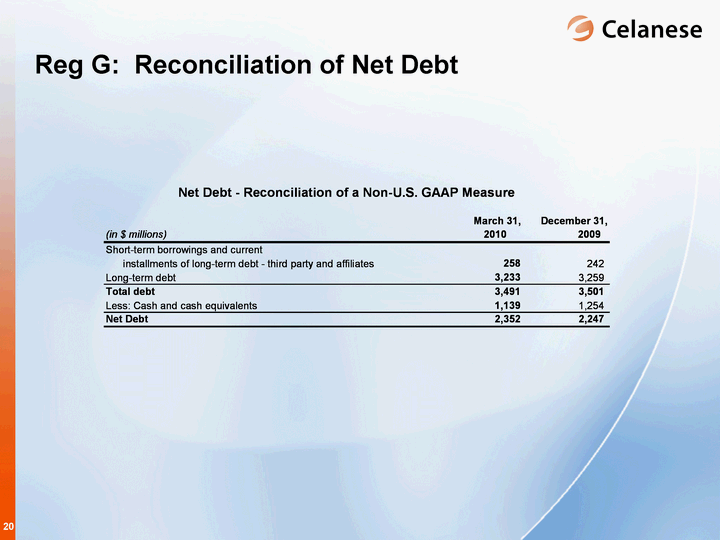
| Reg G: Reconciliation of Net Debt |
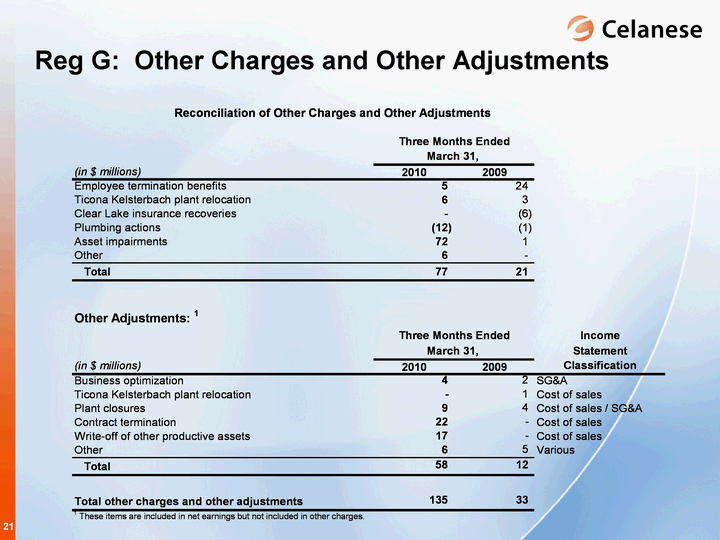
| Reg G: Other Charges and Other Adjustments |
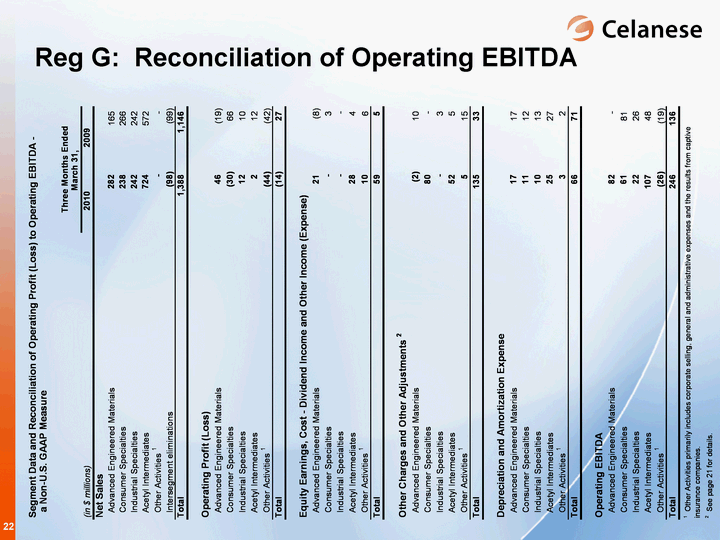
| Reg G: Reconciliation of Operating EBITDA |
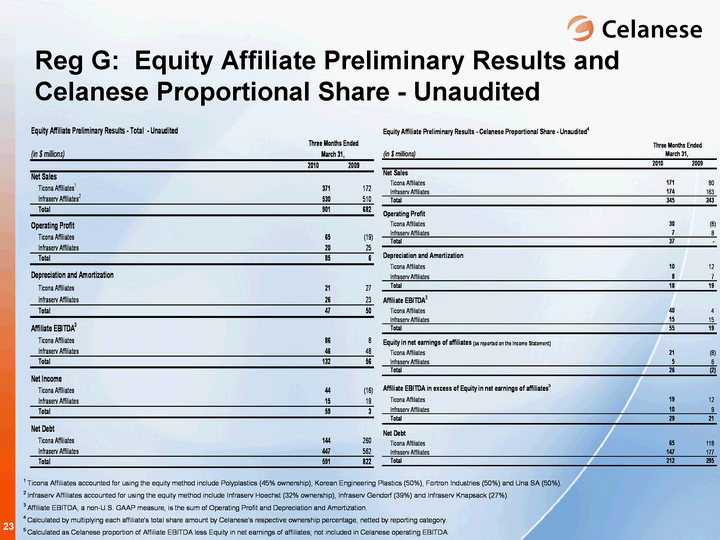
| Reg G: Equity Affiliate Preliminary Results and Celanese Proportional Share - Unaudited |
